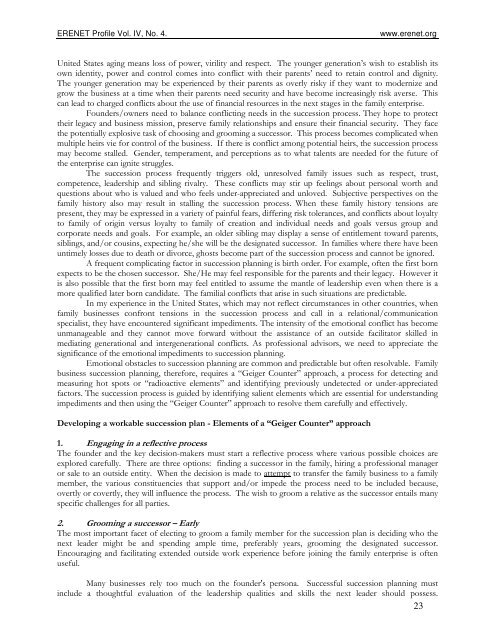Issue 16
Issue 16
Issue 16
You also want an ePaper? Increase the reach of your titles
YUMPU automatically turns print PDFs into web optimized ePapers that Google loves.
ERENET Profile Vol. IV, No. 4.<br />
www.erenet.org<br />
United States aging means loss of power, virility and respect. The younger generation’s wish to establish its<br />
own identity, power and control comes into conflict with their parents’ need to retain control and dignity.<br />
The younger generation may be experienced by their parents as overly risky if they want to modernize and<br />
grow the business at a time when their parents need security and have become increasingly risk averse. This<br />
can lead to charged conflicts about the use of financial resources in the next stages in the family enterprise.<br />
Founders/owners need to balance conflicting needs in the succession process. They hope to protect<br />
their legacy and business mission, preserve family relationships and ensure their financial security. They face<br />
the potentially explosive task of choosing and grooming a successor. This process becomes complicated when<br />
multiple heirs vie for control of the business. If there is conflict among potential heirs, the succession process<br />
may become stalled. Gender, temperament, and perceptions as to what talents are needed for the future of<br />
the enterprise can ignite struggles.<br />
The succession process frequently triggers old, unresolved family issues such as respect, trust,<br />
competence, leadership and sibling rivalry. These conflicts may stir up feelings about personal worth and<br />
questions about who is valued and who feels under-appreciated and unloved. Subjective perspectives on the<br />
family history also may result in stalling the succession process. When these family history tensions are<br />
present, they may be expressed in a variety of painful fears, differing risk tolerances, and conflicts about loyalty<br />
to family of origin versus loyalty to family of creation and individual needs and goals versus group and<br />
corporate needs and goals. For example, an older sibling may display a sense of entitlement toward parents,<br />
siblings, and/or cousins, expecting he/she will be the designated successor. In families where there have been<br />
untimely losses due to death or divorce, ghosts become part of the succession process and cannot be ignored.<br />
A frequent complicating factor in succession planning is birth order. For example, often the first born<br />
expects to be the chosen successor. She/He may feel responsible for the parents and their legacy. However it<br />
is also possible that the first born may feel entitled to assume the mantle of leadership even when there is a<br />
more qualified later born candidate. The familial conflicts that arise in such situations are predictable.<br />
In my experience in the United States, which may not reflect circumstances in other countries, when<br />
family businesses confront tensions in the succession process and call in a relational/communication<br />
specialist, they have encountered significant impediments. The intensity of the emotional conflict has become<br />
unmanageable and they cannot move forward without the assistance of an outside facilitator skilled in<br />
mediating generational and intergenerational conflicts. As professional advisors, we need to appreciate the<br />
significance of the emotional impediments to succession planning.<br />
Emotional obstacles to succession planning are common and predictable but often resolvable. Family<br />
business succession planning, therefore, requires a “Geiger Counter” approach, a process for detecting and<br />
measuring hot spots or “radioactive elements” and identifying previously undetected or under-appreciated<br />
factors. The succession process is guided by identifying salient elements which are essential for understanding<br />
impediments and then using the “Geiger Counter” approach to resolve them carefully and effectively.<br />
Developing a workable succession plan - Elements of a “Geiger Counter” approach<br />
1. Engaging in a reflective process<br />
The founder and the key decision-makers must start a reflective process where various possible choices are<br />
explored carefully. There are three options: finding a successor in the family, hiring a professional manager<br />
or sale to an outside entity. When the decision is made to attempt to transfer the family business to a family<br />
member, the various constituencies that support and/or impede the process need to be included because,<br />
overtly or covertly, they will influence the process. The wish to groom a relative as the successor entails many<br />
specific challenges for all parties.<br />
2. Grooming a successor – Early<br />
The most important facet of electing to groom a family member for the succession plan is deciding who the<br />
next leader might be and spending ample time, preferably years, grooming the designated successor.<br />
Encouraging and facilitating extended outside work experience before joining the family enterprise is often<br />
useful.<br />
Many businesses rely too much on the founder's persona. Successful succession planning must<br />
include a thoughtful evaluation of the leadership qualities and skills the next leader should possess.<br />
23
















